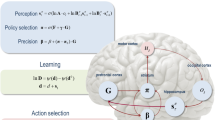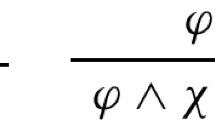Abstract
The syntax of features is a complicated and densely researched domain, from a variety of theoretical perspectives. The present paper takes one influential syntactic framework [the minimalist program of Chomsky, 1995] as its vantage point, and discusses the major issues that arise within this framework in the domain of the syntax of features, with particular emphasis on Case and agreement.
Similar content being viewed by others
REFERENCES
Ausín, A. (1999). Chinese-type questions in English. WCCFL XVII Proceedings.
Babyonyshev, M., & Gibson, E. (1995). Processing overload in Japanese. MIT Working Papers in Linguistics.
Beghelli, F., & Stowell, T. (1997). Distributivity and negation. In A. Szabolcsi (ed.), Ways of scope taking. Dordrecht: Kluwer.
Bejar, S. (1999). Structural markedness and minimalist checking theory. Paper presented at WCCFL 18, Arizona, April 1999.
Bennis, H., & Haegeman, L. (1984). On the status of agreement and relative clauses in West-Flemish. In W. de Geest & Y. Putseys (Eds.), Sentential complementation (pp. 33–55). Dordrecht: Foris.
Bock, K., & Eberhard, K. (1993). Meaning, sound and syntax in English number agreement. Language and Cognitive Processes, 8, 57–99.
Bock, K., & Miller, C. (1991). Broken agreement. Cognitive Psychology, 23, 45–93.
Borer, H. (1984). Parametric syntax. Dordrecht: Foris.
Boškovič, Ž. (1997). The syntax of non-finite complementation. Cambridge, MA: MIT Press.
Chomsky, N. (1955). The logical structure of linguistic theory (Published 1975). New York: Plenum.
Chomsky, N. (1986a). Knowledge of language. Its nature, origin and use. New York: Praeger.
Chomsky, N. (1986b). Barriers. Cambridge, MA: MIT Press.
Chomsky, N. (1991). Some notes on economy of derivation and representation. In Robert Freidin (ed.), Principles and parameters in comparative grammar. Cambridge, MA: MIT Press.
Chomsky, N. (1995). The minimalist program. Cambridge, MA: MIT Press.
Chomsky, N. (1998). Minimalist inquiries: The framework. Ms., MIT.
Clahsen, H., Bartke, S. & Göllner, S. (1997). Formal features in impaired grammars: A comparison of English and German SLI children. Journal of Neurolinguistics, 10, 151–171.
Elbourne, P. (1999). Some correlations between semantic plurality and quantifier scope. In NELS 29 Proceedings. Amherst: GLSA.
Fox, D. (1995). Economy, scope and semantic interpretation. Evidence from VP ellipsis, Ms., MIT.
Fox, D. (1998). Economy and semantic interpretation. Ph.D. Dissertation, MIT.
Francis, W. N. (1986). Proximity concord in English. Journal of English Linguistics, 19, 309–318.
Franks, S. (1999). Clitics at the interface. In F. Beukema, & M. den Dikken (Eds.), Clitic phenomena in European languages (in press). Amsterdam: John Benjamins.
Gazdar, G., Klein, E., Pullum, G., & Sag, I. (1985). Generalized Phrase Structure Grammar. Cambridge, MA: Harvard University Press.
Groat, E., & O'Neil, J. (1996). Spell-Out and the LF interface. In W. Abraham et al. (Eds.), Minimal Ideas (pp. 113–139). Amsterdam: John Benjamins.
Heim, I., & Kratzer, A. (1998). Semantics in generative grammar. Oxford: Blackwell.
Holmberg, A. (1986). Word order and syntactic features in the Scandinavian languages and English. Ph.D. Dissertation. University of Stockholm.
Jaeggli, O., & Safir, K., (1989). The null subject parameter. Dordrecht: Kluwer.
Kayne, R. (1989). Notes on English agreement. Ms., CUNY Graduate Center.
Kayne, R. (1998). A note on prepositions and complementisers. Posted on the MIT Press website celebrating Noam Chomsky's 70th birthday.
Kimball, J., & Aissen, J. (1971). I think, you think, he think. Linguistic Inquiry, 2, 241–246.
Lasnik, H. (1999). On feature strength: Three minimalist approaches to overt movement. Linguistic Inquiry, 30, 197–217.
Lebeaux, D. (1983). A distributional difference between reciprocals and reflexives. Linguistic Inquiry, 14, 723–30.
Mak, P., Vonk, W., & Schriefers, H. (1999). The influence of animacy on the initial parse of Dutch relative clauses. Poster presented at the 12th CUNY Conference on Human Sentence Processing, New York, March, 1999.
Meng, M., & Bader, M. (1998). Mode of disambiguation and garden-path strength. An investigation of subject–object ambiguities in German. To appear.
Nichols, L. (1999). Anomalous agreement and locality in lexical structure. Ms.
Nowak, A. (1999). The role of overt case on parsing in Polish. Poster presented at the 12th CUNY Conference on Human Sentence Processing, New York, March, 1999.
Pica, P. (1987). On the nature of the reflexivization cycle. In J. McDonough & B. Plunkett (Eds.), Proceedings of NELS 17. Amherst: GLSA.
Pollard, C., & Sag, I. (1994). Head-driven phrase structure grammar. Chicago: University of Chicago Press.
Pollock, J-Y. (1989). Verb movement, Universal Grammar, and the structure of IP. Linguistic Inquiry, 20, 365–424.
Radford, A. (1997). Syntactic theory and the structure of English. A minimalist approach. Cambridge: CUP.
Reid, W. (1991). Verb & noun number in English: A functional explanation. London/New York: Longman.
Richards, N. (1997). What moves where when in which language?. Ph.D. Dissertation, MIT.
Roberts, I., & Shlonsky, U. (1996). Pronominal enclisis in VSO languages. In R. Borsley & I. Roberts (Eds.), The syntax of the Celtic languages. Cambridge: Cambridge University Press.
Rohrbacher, B. (1994). The Germanic VO languages and the full paradigm: A theory of V to I raising. Ph.D. Dissertation, University of Massachusetts.
Schlesewsky, M., & Fanselow, G. (1999). Case features as a trigger for reanalysis. Poster presented at the 12th CUNY Conference on Human Sentence Processing, New York, March, 1999.
Strang, B. M. H. (1966). Some features of S-V concord in present-day English. In I. Cellini & G. Melchiori (Eds.), English studies today: Fourth series (pp. 73–87). Rome: Edizioni di Storia e Letteratura.
Thornton, R., & MacDonald, M. C. (1999). Plausibility effects on subject-verb agreement errors in English. Poster presented at the 12th CUNY Conference on Human Sentence Processing, New York, March, 1999.
Wu, A. (1994). The Spell-Out parameters. A minimalist approach to syntax. Ph.D. Dissertation, University of California Los Angeles.
Zwart, J-W. (1997). Morphosyntax of verb movement. A minimalist approach to the syntax of Dutch. Dordrecht: Kluwer.
Author information
Authors and Affiliations
Rights and permissions
About this article
Cite this article
den Dikken, M. The Syntax of Features. J Psycholinguist Res 29, 5–23 (2000). https://doi.org/10.1023/A:1005116221991
Issue Date:
DOI: https://doi.org/10.1023/A:1005116221991




